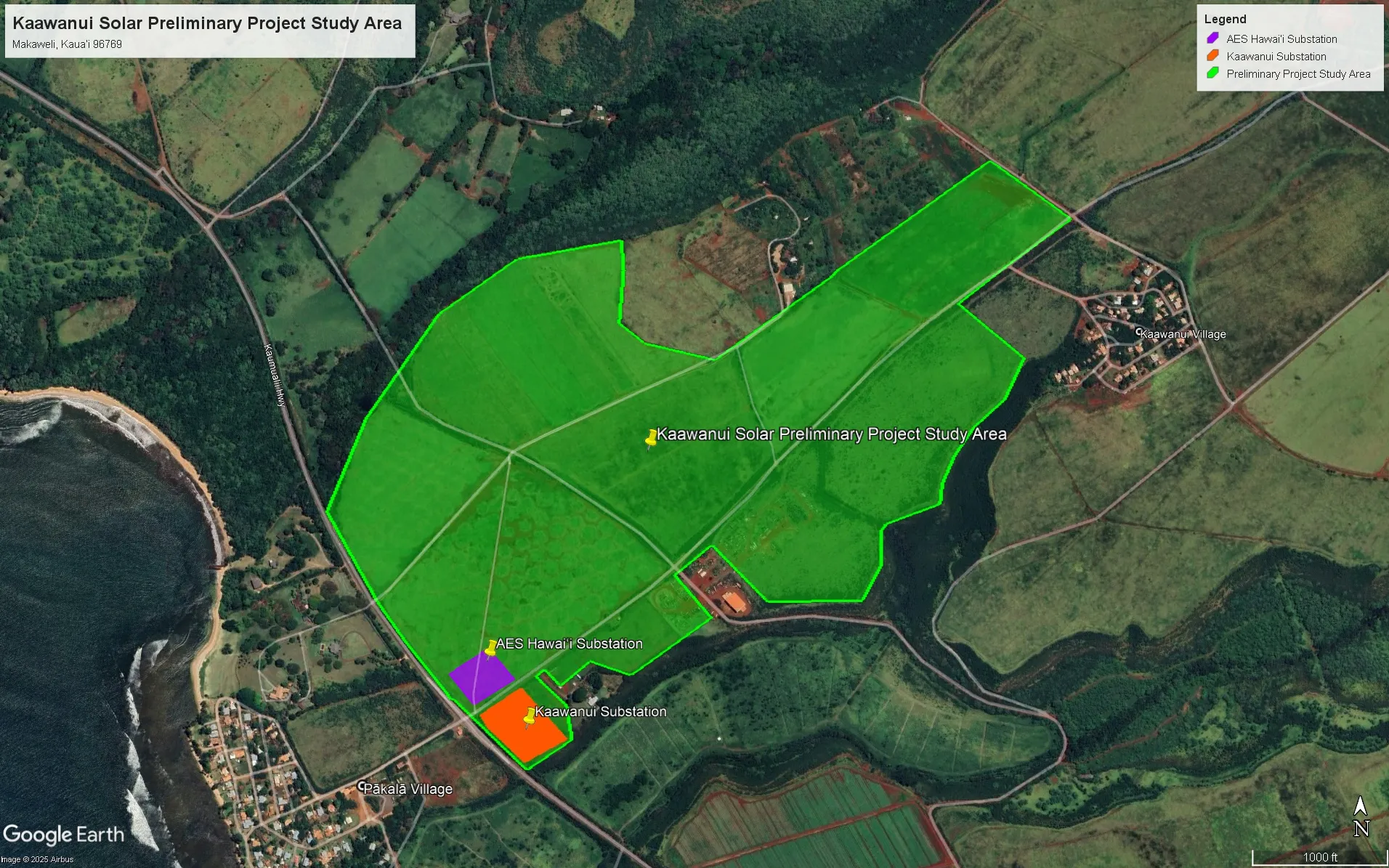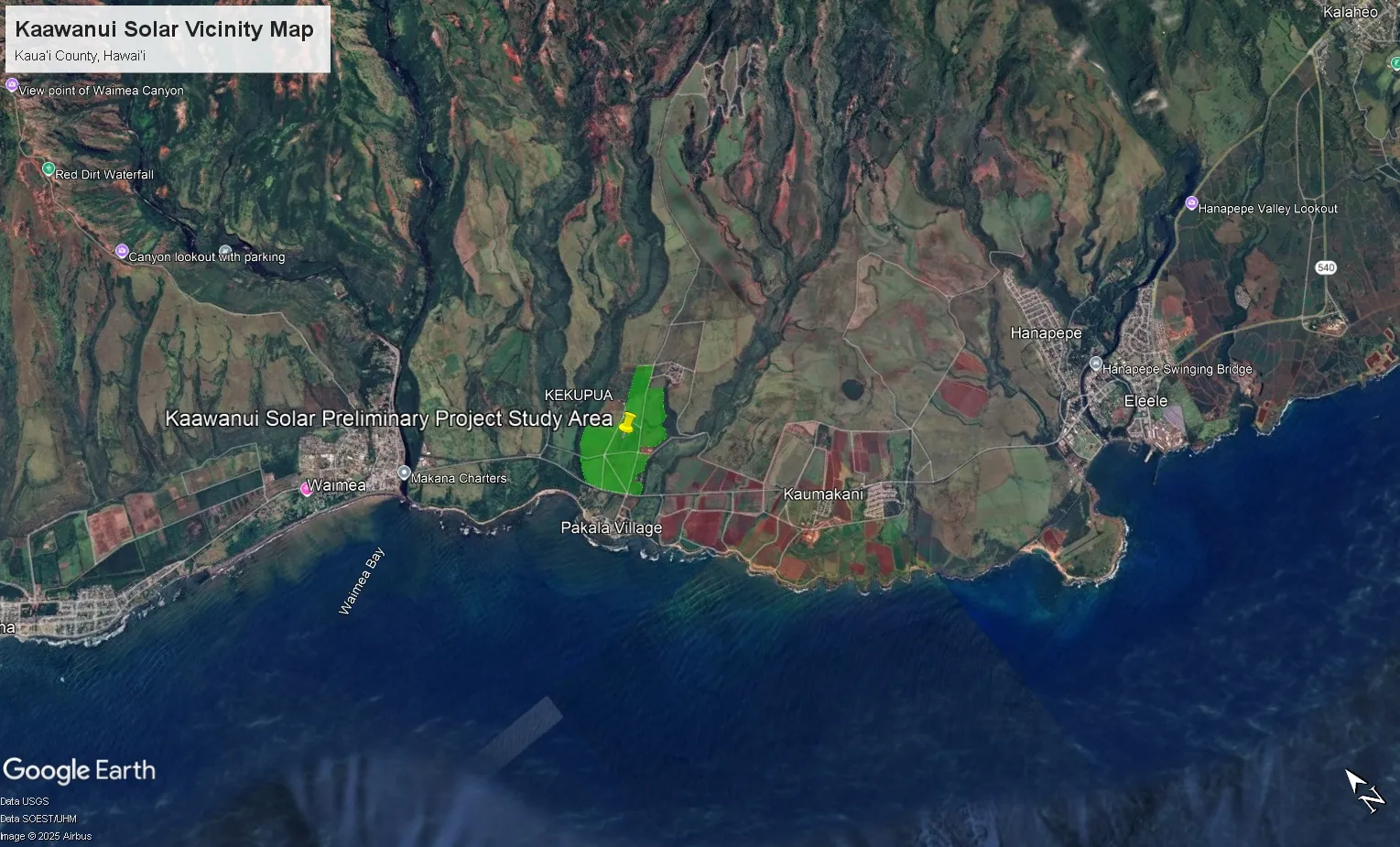Project summary
Kaawanui Solar is a proposed 43 MW photovoltaic array paired with 4 hours of battery storage capacity [172 MWh Battery Energy Storage System (BESS)]. The proposed Project is located on land managed by Gay & Robinson, Inc. in Makaweli. The Project will be developed and operated by AES Hawaiʻi. It will deliver power at a low, fixed price to Kauaʻi Island Utility Cooperative’s (KIUC) island-wide electrical grid over a 25-year contract term. The Project will include the design and construction of a switchyard, the “Kaawanui Substation,” which will allow the Project to connect to KIUC’s electrical grid. The Project is anticipated to enter commercial operation in 2028.
- Specifications: 43 MW solar photovoltaic array plus 172 MWh containerized lithium-ion BESS.
- Power Purchase Agreement (PPA): Under a 25-year PPA, the Project will deliver power to KIUC's electrical grid to serve Kauaʻi residents.
- Decommissioning: At the end of the Project’s life, AES Hawaiʻi will restore the land to its existing condition (or comparable).
- Preliminary Project Study Area: The Project will be sited within an approximate 269-acre Preliminary Project Study Area. The Project Area, which houses the Project infrastructure, will be a smaller subset of the Preliminary Study Area.
- Compatible Agriculture: In alignment with State law, the Project is being developed to include considerations for compatible agriculture. AES Hawaiʻi is in active partnership discussions on robust agriculture activities that would be co-located at this site, thereby not just helping to achieve 100% renewable energy but also activating agricultural uses of this land.
Kauaʻi’s 100% clean energy future
AES Hawaiʻi is partnering with the Kauaʻi Island Utility Cooperative (KIUC) to help realize their strategic goal of generating 100% of Kauaʻi’s electricity from renewable sources by 2033. This effort aims to reduce power costs, decrease reliance on imported fossil fuels, and increase the amount of energy generated from Kauaʻi’s resources. In 2019, we made history together by bringing online the Lāwaʻi Solar + Storage Project, which was the largest operational solar and energy storage system in the world at the time. In 2021, in collaboration with the U.S. Navy, we also brought Kekaha Solar + Storage online (also known as the AES PMRF Project). Working together, we are co-creating solutions that help stabilize rates, increase grid reliability, and support Kauaʻi's goals for renewable generation.
Preliminary study area

The Project Area, which houses the Project infrastructure, will be a smaller subset of the Preliminary Study Area. The Project will also include an AES Hawaiʻi Substation and new KIUC switchyard, the “Kaawanui Substation,” which will connect the Project to the KIUC grid.
Community outreach
AES Hawaiʻi is deeply committed to engaging with the community early and often throughout the Project’s lifespan.
AES Hawaiʻi and KIUC are committed to being active, invested members of the communities we serve. Being a responsible community partner is fundamental to our values and drives our approach to developing Kaawanui Solar.
We are committed to proactively engaging and consulting with stakeholders throughout the development process. Our community outreach efforts will include but are not limited to, informing stakeholders and neighboring communities of the Project’s proposed design, soliciting feedback and answering questions, and proactively identifying and mitigating concerns.
Community Outreach Representative: Carrice Gardner
We invite you to share your feedback on the Project via the “Contact Us” link at the bottom of this website or by emailing us at kaawanuisolar@aes.com.
Cultural and archaeological resources
AES Hawaiʻi takes the archaeological and cultural resources review very seriously. As we have done for all Hawai‘i projects previously developed or currently in development, this Project will undergo extensive archaeological and cultural reviews to gain a comprehensive understanding of the land and any potential impacts resulting from the proposed development. All steps will be taken to carefully record, avoid, and/or mitigate impacts on archeological and cultural resources to the extent practicable. Past practices that may be utilized for this Project include but are not limited to hiring local on-island firms to perform an Archaeological Inventory Survey (AIS), Ka Paʻakai Analysis, and Archeological Literature Review and Field Inspection Report (LRFI). These initiatives will often include interviews and consultation with lineal and cultural descendants, kūpuna, Native Hawaiian Organizations (NHOs), agencies, and area cultural leaders, as well as presentations to interested groups and parties.
AES Hawaiʻi has engaged a local archeological firm and cultural consultancy to conduct an early-stage initial analysis that identifies:
- Valued cultural, historical, or natural resources in the area in question, including the extent to which traditional and customary Native Hawaiian rights are exercised in the area;
- The extent to which those resources, including traditional and customary Native Hawaiian rights, will be affected or impaired by the proposed action; and
-
The feasible action, if any, to be taken to reasonably protect any identified cultural, historical, or natural resources in the area in question, as well as the reasonable protection of traditional and customary Native Hawaiian rights in the affected area.
Archaeological
-
The Project’s first step was to commission an LRFI. This study includes a thorough archaeological literature review and field inspection designed to survey and visually inspect the proposed project area to identify the potential for archaeological historic property features. The results of this study will inform AES Hawaiʻi’s consultation with the State Historic Preservation Division (SHPD) as part of the Hawaiʻi Revised Statutes (HRS) §6E review and will help determine the strategy for additional archaeological studies, as required by SHPD.
Cultural
-
AES Hawaiʻi is committed to conducting a Ka Paʻakai Analysis.
Environmental studies
AES Hawaiʻi and its environmental consultants are assessing the site’s environmental conditions based on the review of publicly available maps, studies, and previous environmental reports prepared for the property. Detailed information is being obtained through due diligence and site-specific studies. The results of these studies will inform the Project design, which will seek to avoid and minimize environmental impacts to the extent practicable. Best Management Practices (BMPs) will be implemented to minimize impacts throughout the Project lifecycle.
Contact us
We appreciate your interest and participation in Kauaʻi’s renewable energy future. We look forward to hearing your ideas and comments through the “Contact us” form below or by emailing the Project at kaawanuisolar@aes.com. By filling out the “Contact us” form, you will automatically be added to the Project mailing list and will receive Project updates.
Community Outreach Representative:
Carrice Gardner
Email: kaawanuisolar@aes.com
Project Hotline: 808-800-3942


